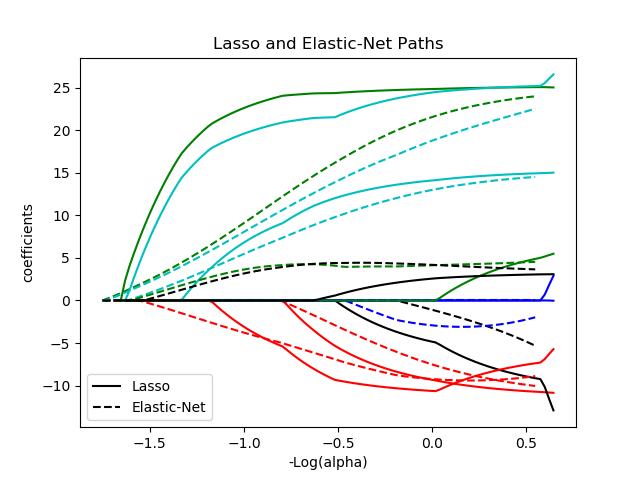sklearn.linear_model.enet_path¶
sklearn.linear_model.enet_path(X, y, *, l1_ratio=0.5, eps=0.001, n_alphas=100, alphas=None, precompute='auto', Xy=None, copy_X=True, coef_init=None, verbose=False, return_n_iter=False, positive=False, check_input=True, **params)
[源码]
计算具有坐标下降的弹性网络路径。
对于单输出和多输出,弹性网络优化函数各不相同。
单输出任务为:
多输出任务为:
(1 / (2 * n_samples)) * ||Y - XW||^Fro_2
+ alpha * l1_ratio * ||W||_21
+ 0.5 * alpha * (1 - l1_ratio) * ||W||_Fro^2
其中:
||W||_21 = \sum_i \sqrt{\sum_j w_{ij}^2}
即每一行的范数之和。
在用户指南中阅读更多内容。
| 参数 | 说明 |
|---|---|
| X | {array-like, sparse matrix} of shape (n_samples, n_features) 用于训练的数据。直接作为Fortran-contiguous数据传递,避免不必要的内存重复。如果 y是单输出,则X 可以是稀疏的。 |
| y | {array-like, sparse matrix} of shape (n_samples,) or (n_samples, n_outputs) 目标值。 |
| l1_ratio | float, default=0.5 0到1之间的数字传递给弹性网(在l1和l2惩罚之间缩放)。 l1_ratio=1对应于套索(Lasso)。 |
| eps | float, default=1e-3 路径的长度。 eps=1e-3意味着alpha_min / alpha_max = 1e-3 |
| n_alphas | int, default=100 沿着正则化路径的Alpha数。 |
| alphas | ndarray, default=None 用于在其中计算模型的alpha列表。如果为None,则自动设置Alpha。 |
| precompute | ‘auto’, bool or array-like of shape (n_features, n_features), default=’auto’ 是否使用预先计算的Gram矩阵来加快计算速度。如果设置 'auto'让我们决定。Gram矩阵也可以作为参数被传递。 |
| Xy | array-like of shape (n_features,) or (n_features, n_outputs), default=None 可以预先计算Xy = np.dot(XT,y)。仅当预先计算了Gram矩阵时才有用。 |
| copy_X | bool, default=True 如果为 True,将复制X;否则,它可能会被覆盖。 |
| coef_init | ndarray of shape (n_features, ), default=None 系数的初始值。 |
| verbose | bool or int, default=False 详细程度。 |
| return_n_iter | bool, default=False 是否返回迭代次数。 |
| positive | bool, default=False 如果设置为True,则强制系数为正。(仅当 y.ndim == 1时允许)。 |
| check_input | bool, default=True 跳过输入验证检查,包括提供的Gram矩阵(假设提供),假设在check_input = False时由调用方处理。 |
| **params | kwargs 关键字参数传递给坐标下降求解器。 |
| 返回值 | 说明 |
|---|---|
| alphas | ndarray of shape (n_alphas,) 沿模型计算路径的Alpha。 |
| coefs | ndarray of shape (n_features, n_alphas) or (n_outputs, n_features, n_alphas) 沿路径的系数。 |
| dual_gaps | ndarray of shape (n_alphas,) 每个alpha优化结束时的双重间隔。 |
| n_iters | list of int 坐标下降优化器为达到每个alpha的指定公差所进行的迭代次数。(当 return_n_iter设置为True 时返回)。 |
另见:
注
有关示例,请参阅examples/linear_model/plot_lasso_coordinate_descent_path.py.





